Financial Management Assignment - University Name, SBS MBA/MSC
VerifiedAdded on 2022/09/15
|12
|1864
|10
Homework Assignment
AI Summary
This Financial Management assignment addresses key concepts including corporate tax liability calculation based on given tax rates and taxable income, and substantiates the role of government taxation in financing expenditures and achieving social and economic objectives. It analyzes investment returns, risk, and diversification using data from two stocks, comparing their risk-return ratios. The assignment also covers the determination of financing requirements, and the application of the time value of money. It also delves into international operations, forex risk and mitigation, and core financial principles such as risk-return trade-offs, cash management, incremental cash flows, and agency problems, along with ethical considerations and market dynamics.

Running head: FINANCIAL MANAGEMENT
Financial Management
Name of the Student:
Name of the University:
Author’s Note:
Financial Management
Name of the Student:
Name of the University:
Author’s Note:
Paraphrase This Document
Need a fresh take? Get an instant paraphrase of this document with our AI Paraphraser
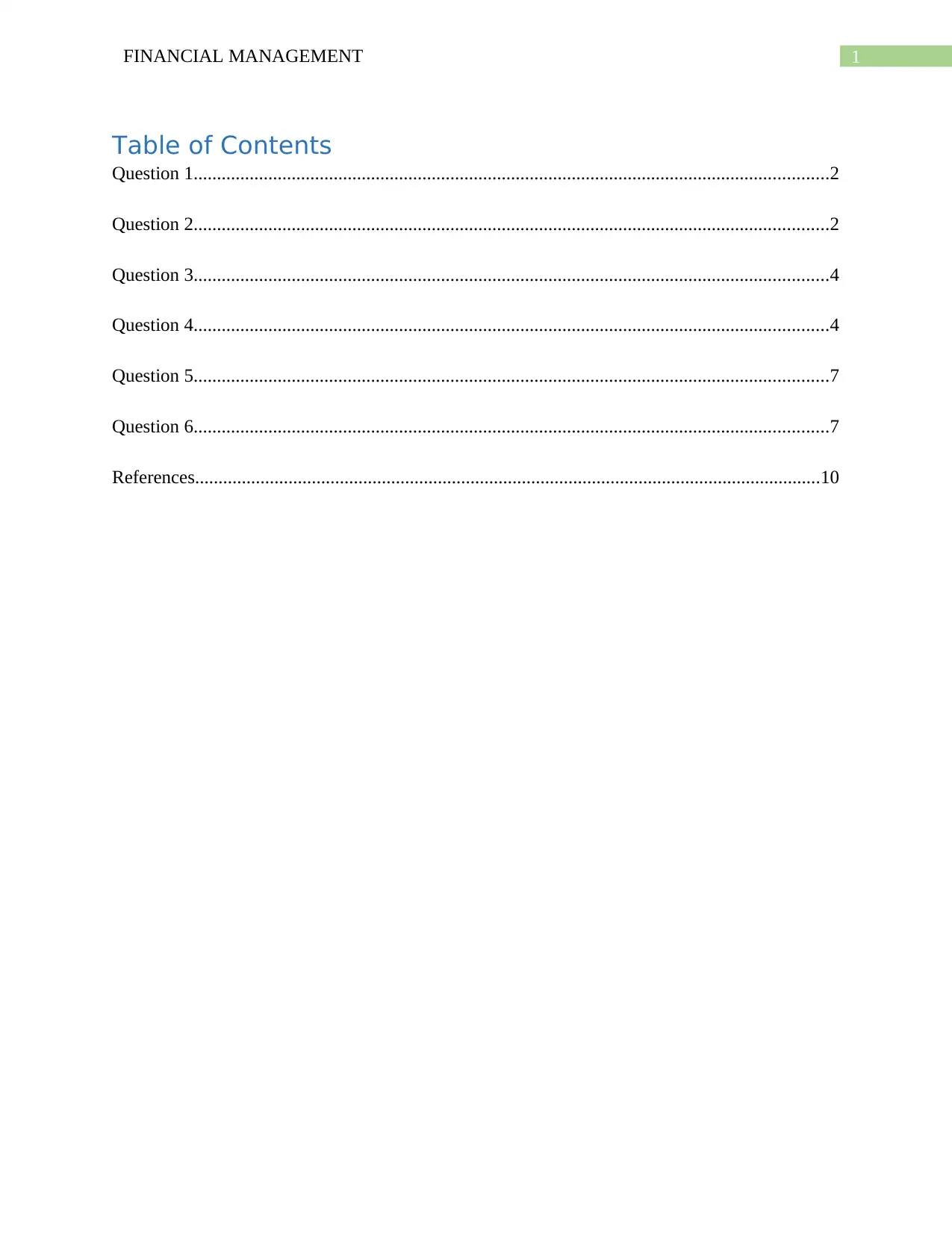
1FINANCIAL MANAGEMENT
Table of Contents
Question 1........................................................................................................................................2
Question 2........................................................................................................................................2
Question 3........................................................................................................................................4
Question 4........................................................................................................................................4
Question 5........................................................................................................................................7
Question 6........................................................................................................................................7
References......................................................................................................................................10
Table of Contents
Question 1........................................................................................................................................2
Question 2........................................................................................................................................2
Question 3........................................................................................................................................4
Question 4........................................................................................................................................4
Question 5........................................................................................................................................7
Question 6........................................................................................................................................7
References......................................................................................................................................10
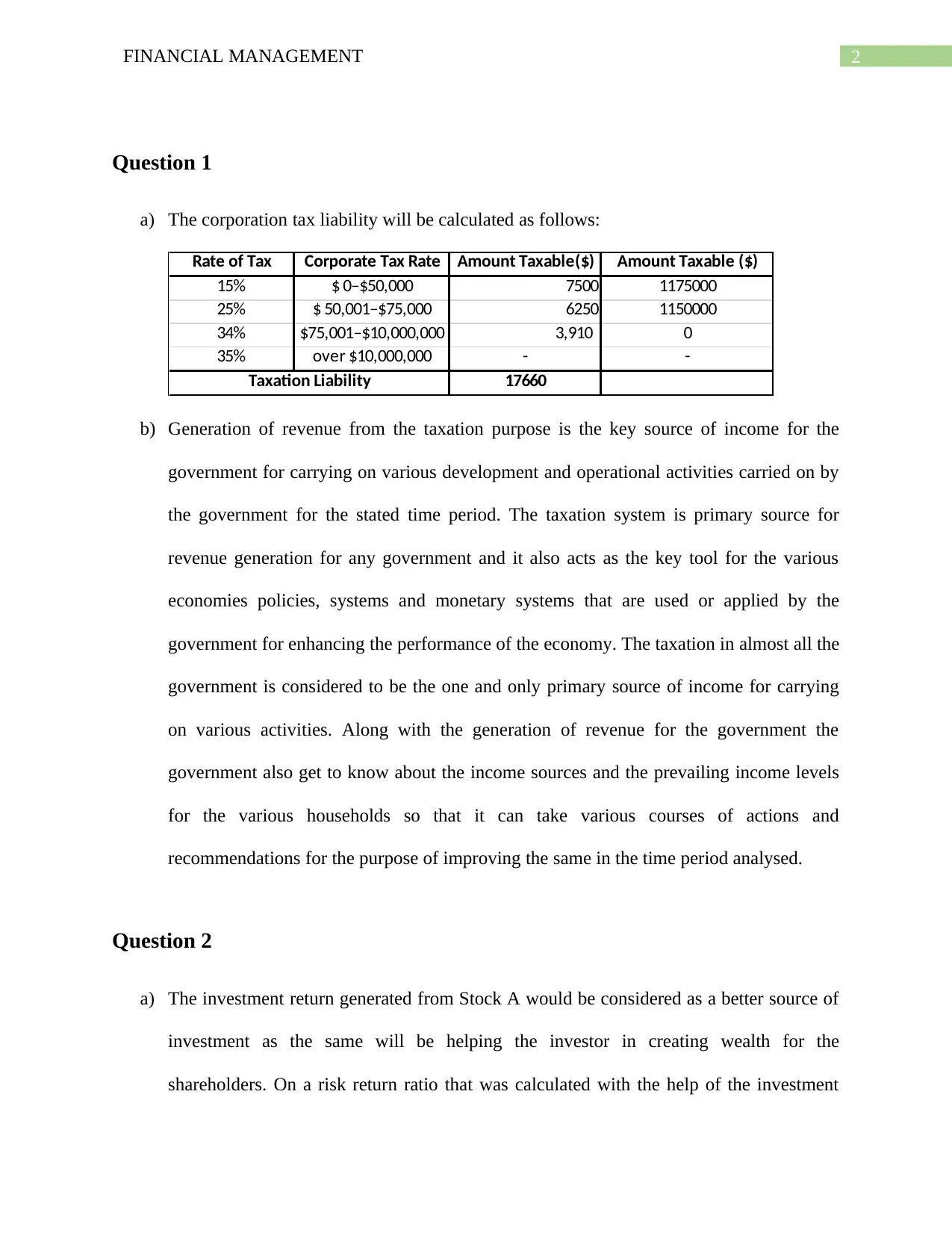
2FINANCIAL MANAGEMENT
Question 1
a) The corporation tax liability will be calculated as follows:
Rate of Tax Corporate Tax Rate Amount Taxable($) Amount Taxable ($)
15% $ 0–$50,000 7500 1175000
25% $ 50,001–$75,000 6250 1150000
34% $75,001–$10,000,000 3,910 0
35% over $10,000,000 - -
17660Taxation Liability
b) Generation of revenue from the taxation purpose is the key source of income for the
government for carrying on various development and operational activities carried on by
the government for the stated time period. The taxation system is primary source for
revenue generation for any government and it also acts as the key tool for the various
economies policies, systems and monetary systems that are used or applied by the
government for enhancing the performance of the economy. The taxation in almost all the
government is considered to be the one and only primary source of income for carrying
on various activities. Along with the generation of revenue for the government the
government also get to know about the income sources and the prevailing income levels
for the various households so that it can take various courses of actions and
recommendations for the purpose of improving the same in the time period analysed.
Question 2
a) The investment return generated from Stock A would be considered as a better source of
investment as the same will be helping the investor in creating wealth for the
shareholders. On a risk return ratio that was calculated with the help of the investment
Question 1
a) The corporation tax liability will be calculated as follows:
Rate of Tax Corporate Tax Rate Amount Taxable($) Amount Taxable ($)
15% $ 0–$50,000 7500 1175000
25% $ 50,001–$75,000 6250 1150000
34% $75,001–$10,000,000 3,910 0
35% over $10,000,000 - -
17660Taxation Liability
b) Generation of revenue from the taxation purpose is the key source of income for the
government for carrying on various development and operational activities carried on by
the government for the stated time period. The taxation system is primary source for
revenue generation for any government and it also acts as the key tool for the various
economies policies, systems and monetary systems that are used or applied by the
government for enhancing the performance of the economy. The taxation in almost all the
government is considered to be the one and only primary source of income for carrying
on various activities. Along with the generation of revenue for the government the
government also get to know about the income sources and the prevailing income levels
for the various households so that it can take various courses of actions and
recommendations for the purpose of improving the same in the time period analysed.
Question 2
a) The investment return generated from Stock A would be considered as a better source of
investment as the same will be helping the investor in creating wealth for the
shareholders. On a risk return ratio that was calculated with the help of the investment
⊘ This is a preview!⊘
Do you want full access?
Subscribe today to unlock all pages.

Trusted by 1+ million students worldwide
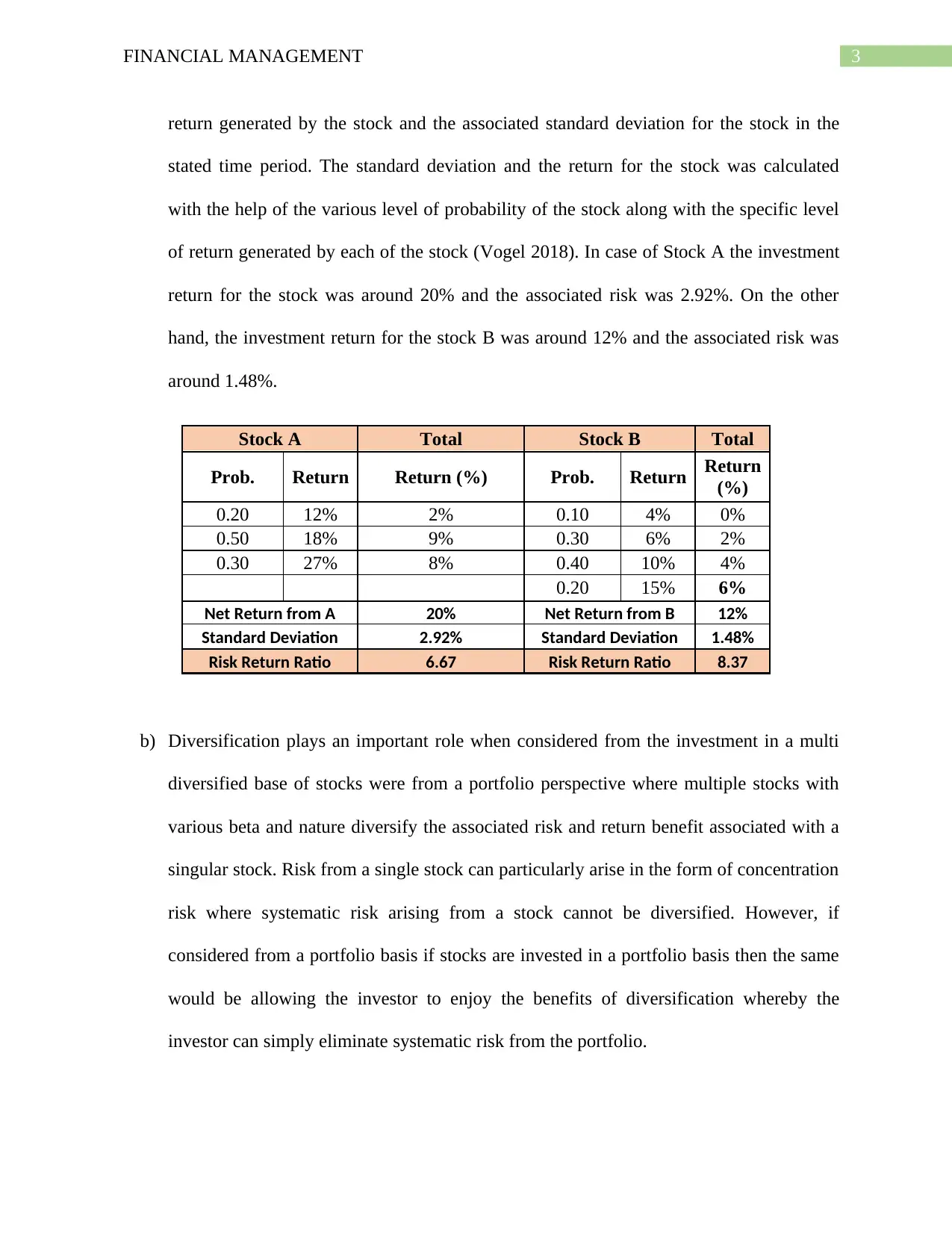
3FINANCIAL MANAGEMENT
return generated by the stock and the associated standard deviation for the stock in the
stated time period. The standard deviation and the return for the stock was calculated
with the help of the various level of probability of the stock along with the specific level
of return generated by each of the stock (Vogel 2018). In case of Stock A the investment
return for the stock was around 20% and the associated risk was 2.92%. On the other
hand, the investment return for the stock B was around 12% and the associated risk was
around 1.48%.
Stock A Total Stock B Total
Prob. Return Return (%) Prob. Return Return
(%)
0.20 12% 2% 0.10 4% 0%
0.50 18% 9% 0.30 6% 2%
0.30 27% 8% 0.40 10% 4%
0.20 15% 6%
Net Return from A 20% Net Return from B 12%
Standard Deviation 2.92% Standard Deviation 1.48%
Risk Return Ratio 6.67 Risk Return Ratio 8.37
b) Diversification plays an important role when considered from the investment in a multi
diversified base of stocks were from a portfolio perspective where multiple stocks with
various beta and nature diversify the associated risk and return benefit associated with a
singular stock. Risk from a single stock can particularly arise in the form of concentration
risk where systematic risk arising from a stock cannot be diversified. However, if
considered from a portfolio basis if stocks are invested in a portfolio basis then the same
would be allowing the investor to enjoy the benefits of diversification whereby the
investor can simply eliminate systematic risk from the portfolio.
return generated by the stock and the associated standard deviation for the stock in the
stated time period. The standard deviation and the return for the stock was calculated
with the help of the various level of probability of the stock along with the specific level
of return generated by each of the stock (Vogel 2018). In case of Stock A the investment
return for the stock was around 20% and the associated risk was 2.92%. On the other
hand, the investment return for the stock B was around 12% and the associated risk was
around 1.48%.
Stock A Total Stock B Total
Prob. Return Return (%) Prob. Return Return
(%)
0.20 12% 2% 0.10 4% 0%
0.50 18% 9% 0.30 6% 2%
0.30 27% 8% 0.40 10% 4%
0.20 15% 6%
Net Return from A 20% Net Return from B 12%
Standard Deviation 2.92% Standard Deviation 1.48%
Risk Return Ratio 6.67 Risk Return Ratio 8.37
b) Diversification plays an important role when considered from the investment in a multi
diversified base of stocks were from a portfolio perspective where multiple stocks with
various beta and nature diversify the associated risk and return benefit associated with a
singular stock. Risk from a single stock can particularly arise in the form of concentration
risk where systematic risk arising from a stock cannot be diversified. However, if
considered from a portfolio basis if stocks are invested in a portfolio basis then the same
would be allowing the investor to enjoy the benefits of diversification whereby the
investor can simply eliminate systematic risk from the portfolio.
Paraphrase This Document
Need a fresh take? Get an instant paraphrase of this document with our AI Paraphraser
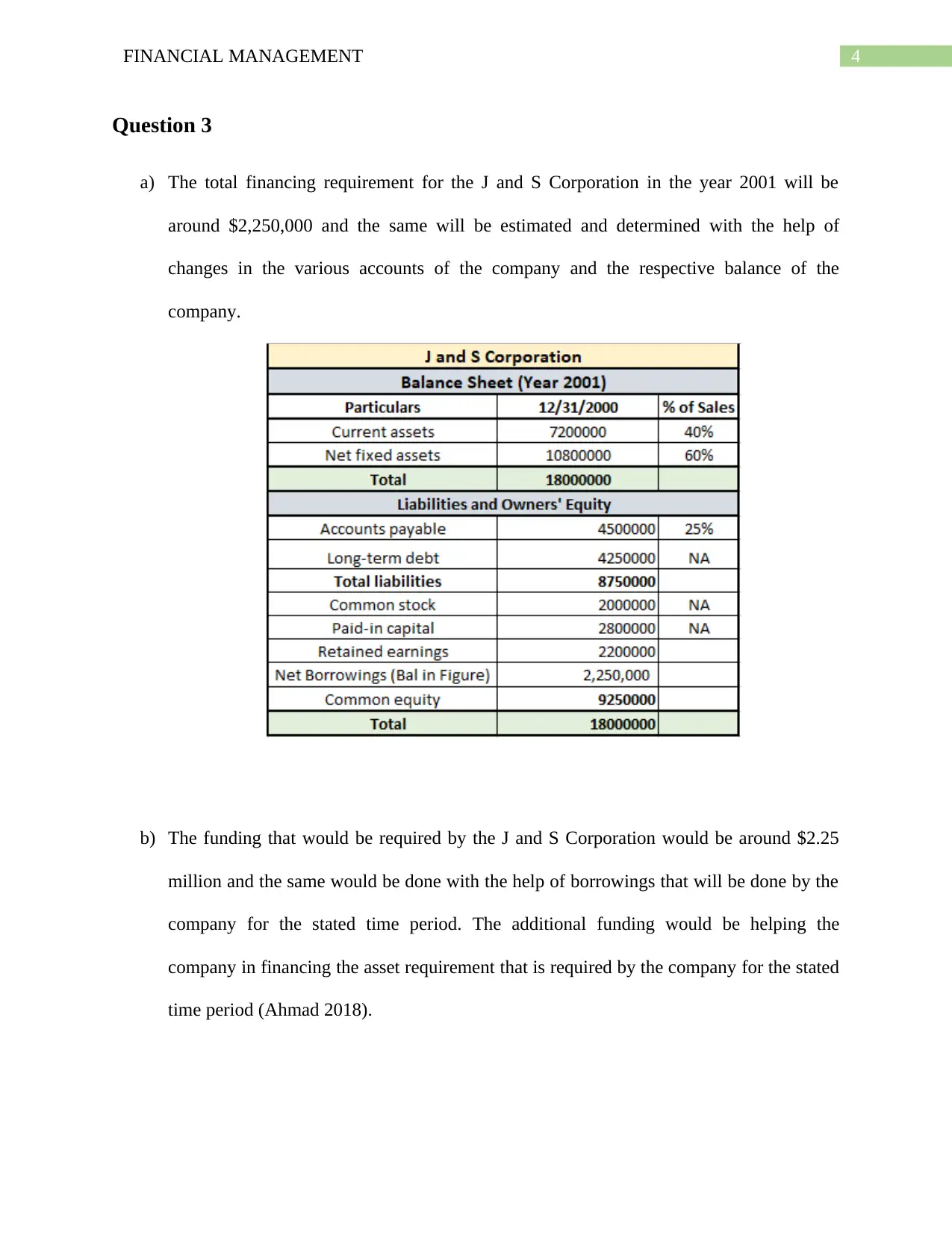
4FINANCIAL MANAGEMENT
Question 3
a) The total financing requirement for the J and S Corporation in the year 2001 will be
around $2,250,000 and the same will be estimated and determined with the help of
changes in the various accounts of the company and the respective balance of the
company.
b) The funding that would be required by the J and S Corporation would be around $2.25
million and the same would be done with the help of borrowings that will be done by the
company for the stated time period. The additional funding would be helping the
company in financing the asset requirement that is required by the company for the stated
time period (Ahmad 2018).
Question 3
a) The total financing requirement for the J and S Corporation in the year 2001 will be
around $2,250,000 and the same will be estimated and determined with the help of
changes in the various accounts of the company and the respective balance of the
company.
b) The funding that would be required by the J and S Corporation would be around $2.25
million and the same would be done with the help of borrowings that will be done by the
company for the stated time period. The additional funding would be helping the
company in financing the asset requirement that is required by the company for the stated
time period (Ahmad 2018).
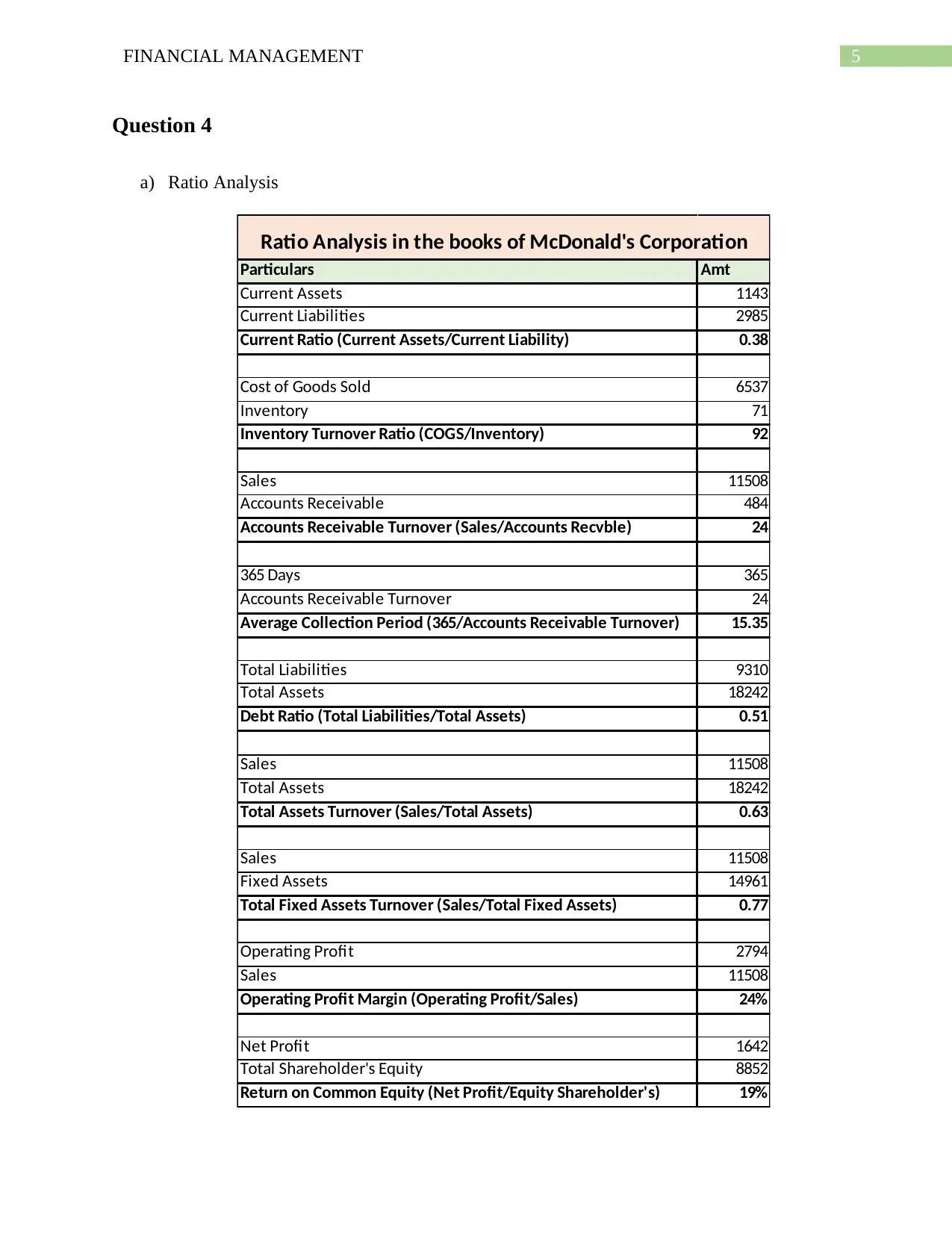
5FINANCIAL MANAGEMENT
Question 4
a) Ratio Analysis
Particulars Amt
Current Assets 1143
Current Liabilities 2985
Current Ratio (Current Assets/Current Liability) 0.38
Cost of Goods Sold 6537
Inventory 71
Inventory Turnover Ratio (COGS/Inventory) 92
Sales 11508
Accounts Receivable 484
Accounts Receivable Turnover (Sales/Accounts Recvble) 24
365 Days 365
Accounts Receivable Turnover 24
Average Collection Period (365/Accounts Receivable Turnover) 15.35
Total Liabilities 9310
Total Assets 18242
Debt Ratio (Total Liabilities/Total Assets) 0.51
Sales 11508
Total Assets 18242
Total Assets Turnover (Sales/Total Assets) 0.63
Sales 11508
Fixed Assets 14961
Total Fixed Assets Turnover (Sales/Total Fixed Assets) 0.77
Operating Profit 2794
Sales 11508
Operating Profit Margin (Operating Profit/Sales) 24%
Net Profit 1642
Total Shareholder's Equity 8852
Return on Common Equity (Net Profit/Equity Shareholder's) 19%
Ratio Analysis in the books of McDonald's Corporation
Question 4
a) Ratio Analysis
Particulars Amt
Current Assets 1143
Current Liabilities 2985
Current Ratio (Current Assets/Current Liability) 0.38
Cost of Goods Sold 6537
Inventory 71
Inventory Turnover Ratio (COGS/Inventory) 92
Sales 11508
Accounts Receivable 484
Accounts Receivable Turnover (Sales/Accounts Recvble) 24
365 Days 365
Accounts Receivable Turnover 24
Average Collection Period (365/Accounts Receivable Turnover) 15.35
Total Liabilities 9310
Total Assets 18242
Debt Ratio (Total Liabilities/Total Assets) 0.51
Sales 11508
Total Assets 18242
Total Assets Turnover (Sales/Total Assets) 0.63
Sales 11508
Fixed Assets 14961
Total Fixed Assets Turnover (Sales/Total Fixed Assets) 0.77
Operating Profit 2794
Sales 11508
Operating Profit Margin (Operating Profit/Sales) 24%
Net Profit 1642
Total Shareholder's Equity 8852
Return on Common Equity (Net Profit/Equity Shareholder's) 19%
Ratio Analysis in the books of McDonald's Corporation
⊘ This is a preview!⊘
Do you want full access?
Subscribe today to unlock all pages.

Trusted by 1+ million students worldwide
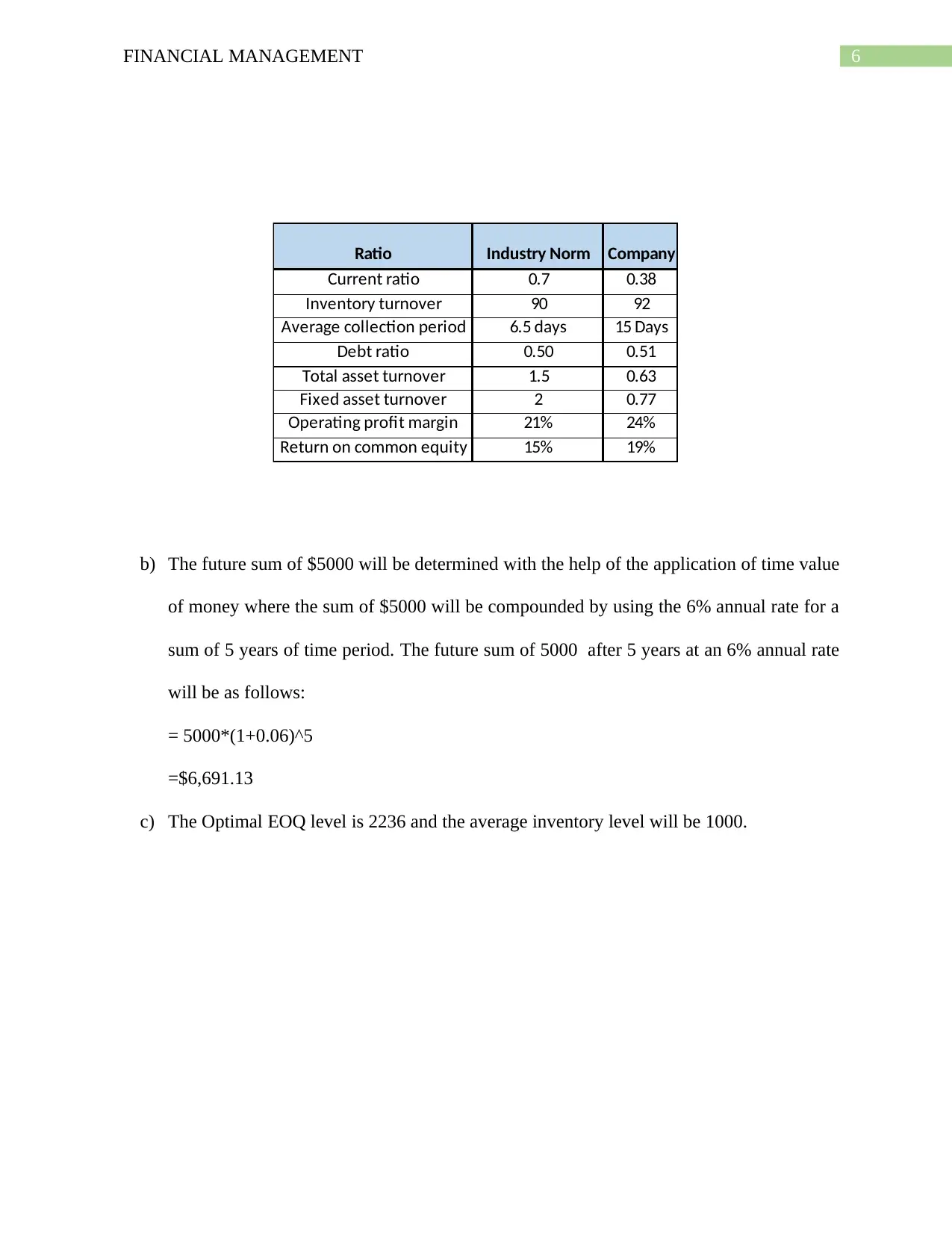
6FINANCIAL MANAGEMENT
Ratio Industry Norm Company
Current ratio 0.7 0.38
Inventory turnover 90 92
Average collection period 6.5 days 15 Days
Debt ratio 0.50 0.51
Total asset turnover 1.5 0.63
Fixed asset turnover 2 0.77
Operating profit margin 21% 24%
Return on common equity 15% 19%
b) The future sum of $5000 will be determined with the help of the application of time value
of money where the sum of $5000 will be compounded by using the 6% annual rate for a
sum of 5 years of time period. The future sum of 5000 after 5 years at an 6% annual rate
will be as follows:
= 5000*(1+0.06)^5
=$6,691.13
c) The Optimal EOQ level is 2236 and the average inventory level will be 1000.
Ratio Industry Norm Company
Current ratio 0.7 0.38
Inventory turnover 90 92
Average collection period 6.5 days 15 Days
Debt ratio 0.50 0.51
Total asset turnover 1.5 0.63
Fixed asset turnover 2 0.77
Operating profit margin 21% 24%
Return on common equity 15% 19%
b) The future sum of $5000 will be determined with the help of the application of time value
of money where the sum of $5000 will be compounded by using the 6% annual rate for a
sum of 5 years of time period. The future sum of 5000 after 5 years at an 6% annual rate
will be as follows:
= 5000*(1+0.06)^5
=$6,691.13
c) The Optimal EOQ level is 2236 and the average inventory level will be 1000.
Paraphrase This Document
Need a fresh take? Get an instant paraphrase of this document with our AI Paraphraser
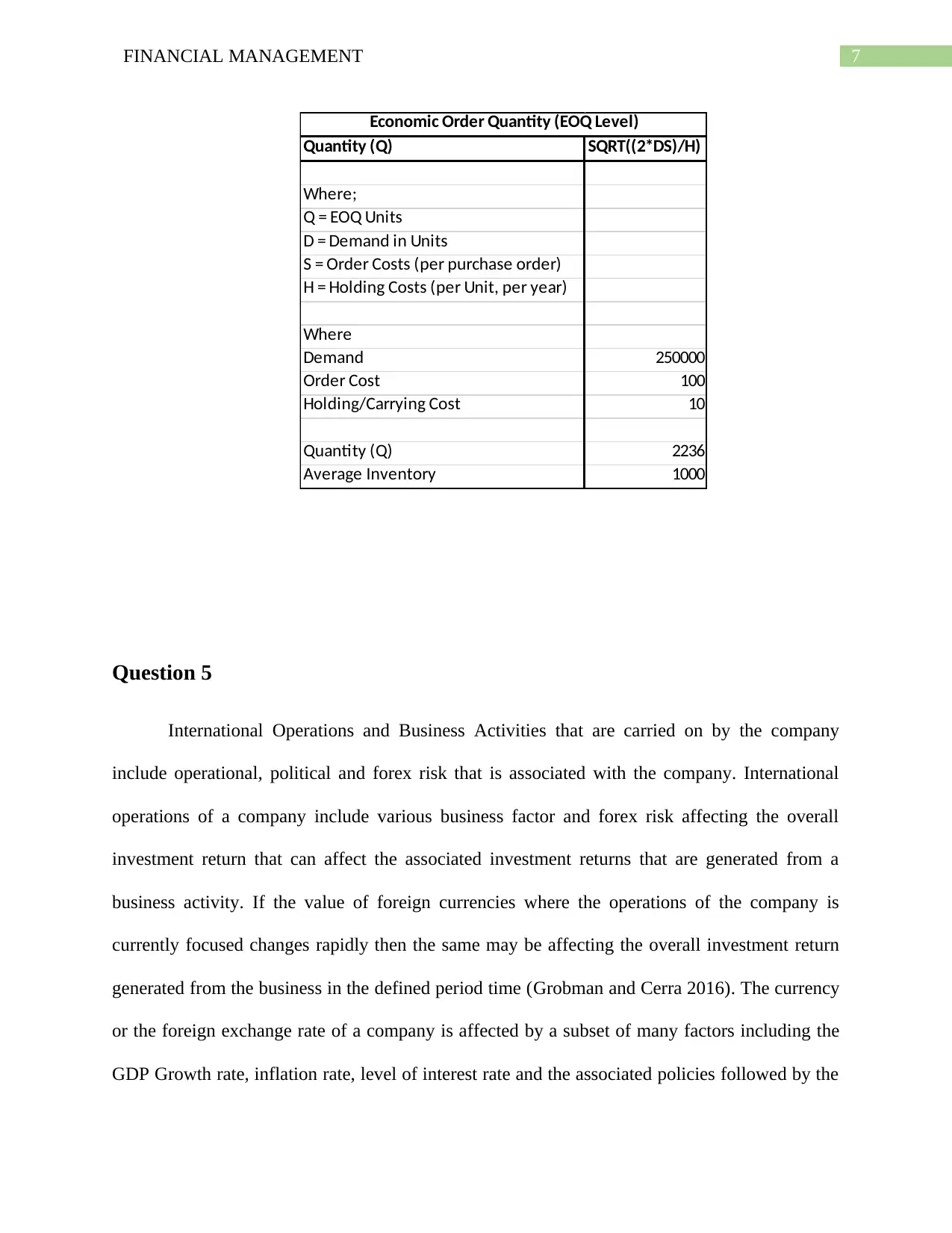
7FINANCIAL MANAGEMENT
Quantity (Q) SQRT((2*DS)/H)
Where;
Q = EOQ Units
D = Demand in Units
S = Order Costs (per purchase order)
H = Holding Costs (per Unit, per year)
Where
Demand 250000
Order Cost 100
Holding/Carrying Cost 10
Quantity (Q) 2236
Average Inventory 1000
Economic Order Quantity (EOQ Level)
Question 5
International Operations and Business Activities that are carried on by the company
include operational, political and forex risk that is associated with the company. International
operations of a company include various business factor and forex risk affecting the overall
investment return that can affect the associated investment returns that are generated from a
business activity. If the value of foreign currencies where the operations of the company is
currently focused changes rapidly then the same may be affecting the overall investment return
generated from the business in the defined period time (Grobman and Cerra 2016). The currency
or the foreign exchange rate of a company is affected by a subset of many factors including the
GDP Growth rate, inflation rate, level of interest rate and the associated policies followed by the
Quantity (Q) SQRT((2*DS)/H)
Where;
Q = EOQ Units
D = Demand in Units
S = Order Costs (per purchase order)
H = Holding Costs (per Unit, per year)
Where
Demand 250000
Order Cost 100
Holding/Carrying Cost 10
Quantity (Q) 2236
Average Inventory 1000
Economic Order Quantity (EOQ Level)
Question 5
International Operations and Business Activities that are carried on by the company
include operational, political and forex risk that is associated with the company. International
operations of a company include various business factor and forex risk affecting the overall
investment return that can affect the associated investment returns that are generated from a
business activity. If the value of foreign currencies where the operations of the company is
currently focused changes rapidly then the same may be affecting the overall investment return
generated from the business in the defined period time (Grobman and Cerra 2016). The currency
or the foreign exchange rate of a company is affected by a subset of many factors including the
GDP Growth rate, inflation rate, level of interest rate and the associated policies followed by the
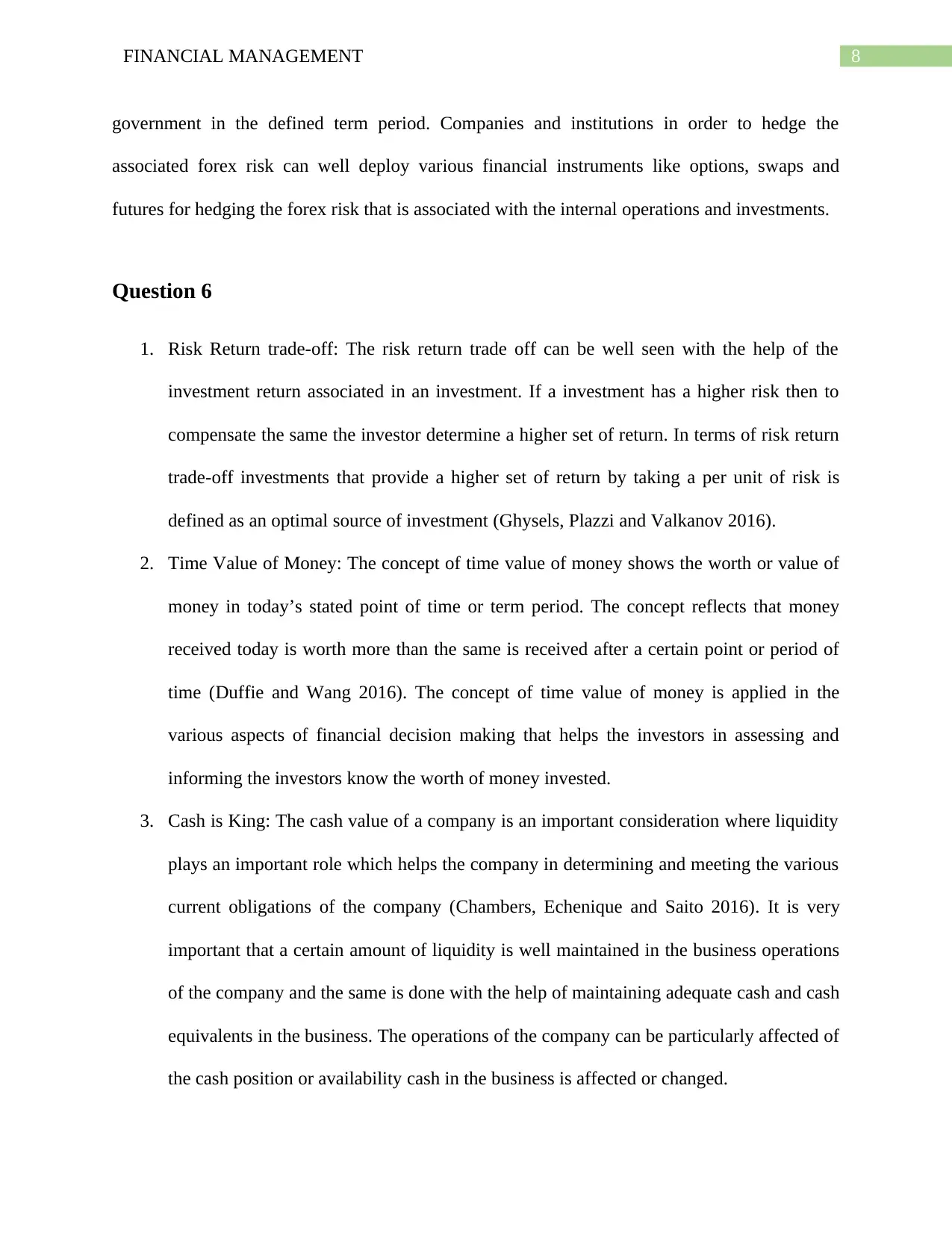
8FINANCIAL MANAGEMENT
government in the defined term period. Companies and institutions in order to hedge the
associated forex risk can well deploy various financial instruments like options, swaps and
futures for hedging the forex risk that is associated with the internal operations and investments.
Question 6
1. Risk Return trade-off: The risk return trade off can be well seen with the help of the
investment return associated in an investment. If a investment has a higher risk then to
compensate the same the investor determine a higher set of return. In terms of risk return
trade-off investments that provide a higher set of return by taking a per unit of risk is
defined as an optimal source of investment (Ghysels, Plazzi and Valkanov 2016).
2. Time Value of Money: The concept of time value of money shows the worth or value of
money in today’s stated point of time or term period. The concept reflects that money
received today is worth more than the same is received after a certain point or period of
time (Duffie and Wang 2016). The concept of time value of money is applied in the
various aspects of financial decision making that helps the investors in assessing and
informing the investors know the worth of money invested.
3. Cash is King: The cash value of a company is an important consideration where liquidity
plays an important role which helps the company in determining and meeting the various
current obligations of the company (Chambers, Echenique and Saito 2016). It is very
important that a certain amount of liquidity is well maintained in the business operations
of the company and the same is done with the help of maintaining adequate cash and cash
equivalents in the business. The operations of the company can be particularly affected of
the cash position or availability cash in the business is affected or changed.
government in the defined term period. Companies and institutions in order to hedge the
associated forex risk can well deploy various financial instruments like options, swaps and
futures for hedging the forex risk that is associated with the internal operations and investments.
Question 6
1. Risk Return trade-off: The risk return trade off can be well seen with the help of the
investment return associated in an investment. If a investment has a higher risk then to
compensate the same the investor determine a higher set of return. In terms of risk return
trade-off investments that provide a higher set of return by taking a per unit of risk is
defined as an optimal source of investment (Ghysels, Plazzi and Valkanov 2016).
2. Time Value of Money: The concept of time value of money shows the worth or value of
money in today’s stated point of time or term period. The concept reflects that money
received today is worth more than the same is received after a certain point or period of
time (Duffie and Wang 2016). The concept of time value of money is applied in the
various aspects of financial decision making that helps the investors in assessing and
informing the investors know the worth of money invested.
3. Cash is King: The cash value of a company is an important consideration where liquidity
plays an important role which helps the company in determining and meeting the various
current obligations of the company (Chambers, Echenique and Saito 2016). It is very
important that a certain amount of liquidity is well maintained in the business operations
of the company and the same is done with the help of maintaining adequate cash and cash
equivalents in the business. The operations of the company can be particularly affected of
the cash position or availability cash in the business is affected or changed.
⊘ This is a preview!⊘
Do you want full access?
Subscribe today to unlock all pages.

Trusted by 1+ million students worldwide
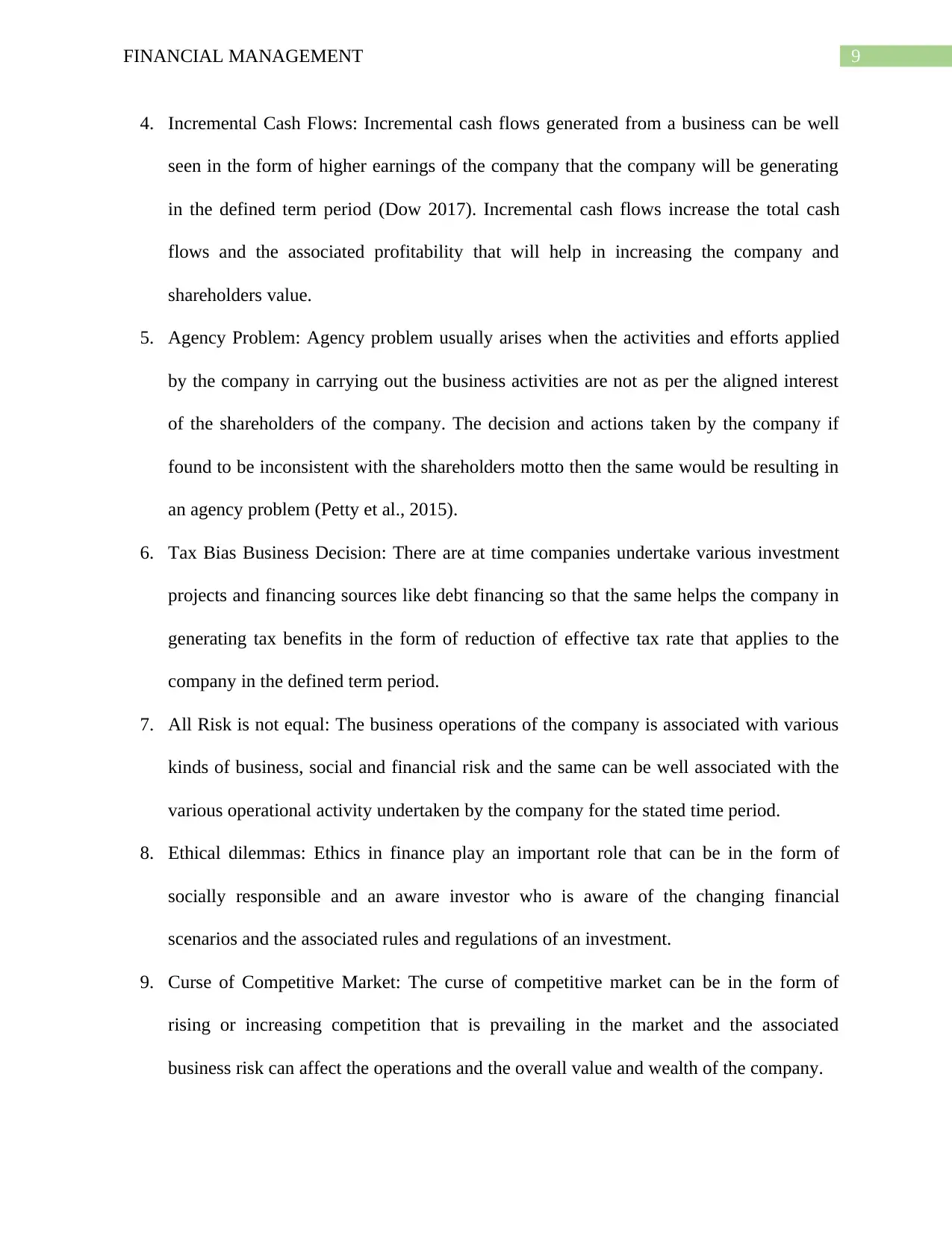
9FINANCIAL MANAGEMENT
4. Incremental Cash Flows: Incremental cash flows generated from a business can be well
seen in the form of higher earnings of the company that the company will be generating
in the defined term period (Dow 2017). Incremental cash flows increase the total cash
flows and the associated profitability that will help in increasing the company and
shareholders value.
5. Agency Problem: Agency problem usually arises when the activities and efforts applied
by the company in carrying out the business activities are not as per the aligned interest
of the shareholders of the company. The decision and actions taken by the company if
found to be inconsistent with the shareholders motto then the same would be resulting in
an agency problem (Petty et al., 2015).
6. Tax Bias Business Decision: There are at time companies undertake various investment
projects and financing sources like debt financing so that the same helps the company in
generating tax benefits in the form of reduction of effective tax rate that applies to the
company in the defined term period.
7. All Risk is not equal: The business operations of the company is associated with various
kinds of business, social and financial risk and the same can be well associated with the
various operational activity undertaken by the company for the stated time period.
8. Ethical dilemmas: Ethics in finance play an important role that can be in the form of
socially responsible and an aware investor who is aware of the changing financial
scenarios and the associated rules and regulations of an investment.
9. Curse of Competitive Market: The curse of competitive market can be in the form of
rising or increasing competition that is prevailing in the market and the associated
business risk can affect the operations and the overall value and wealth of the company.
4. Incremental Cash Flows: Incremental cash flows generated from a business can be well
seen in the form of higher earnings of the company that the company will be generating
in the defined term period (Dow 2017). Incremental cash flows increase the total cash
flows and the associated profitability that will help in increasing the company and
shareholders value.
5. Agency Problem: Agency problem usually arises when the activities and efforts applied
by the company in carrying out the business activities are not as per the aligned interest
of the shareholders of the company. The decision and actions taken by the company if
found to be inconsistent with the shareholders motto then the same would be resulting in
an agency problem (Petty et al., 2015).
6. Tax Bias Business Decision: There are at time companies undertake various investment
projects and financing sources like debt financing so that the same helps the company in
generating tax benefits in the form of reduction of effective tax rate that applies to the
company in the defined term period.
7. All Risk is not equal: The business operations of the company is associated with various
kinds of business, social and financial risk and the same can be well associated with the
various operational activity undertaken by the company for the stated time period.
8. Ethical dilemmas: Ethics in finance play an important role that can be in the form of
socially responsible and an aware investor who is aware of the changing financial
scenarios and the associated rules and regulations of an investment.
9. Curse of Competitive Market: The curse of competitive market can be in the form of
rising or increasing competition that is prevailing in the market and the associated
business risk can affect the operations and the overall value and wealth of the company.
Paraphrase This Document
Need a fresh take? Get an instant paraphrase of this document with our AI Paraphraser
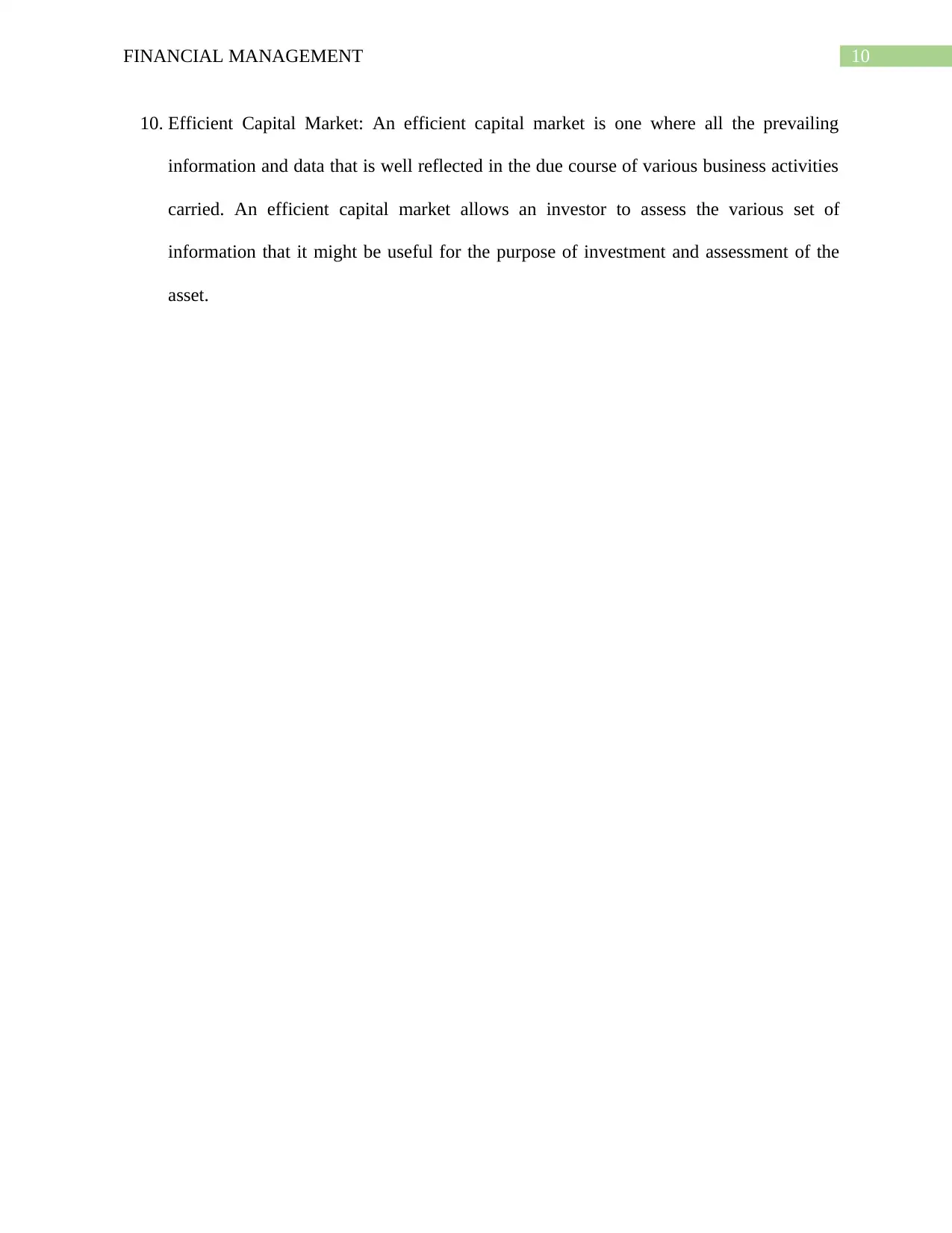
10FINANCIAL MANAGEMENT
10. Efficient Capital Market: An efficient capital market is one where all the prevailing
information and data that is well reflected in the due course of various business activities
carried. An efficient capital market allows an investor to assess the various set of
information that it might be useful for the purpose of investment and assessment of the
asset.
10. Efficient Capital Market: An efficient capital market is one where all the prevailing
information and data that is well reflected in the due course of various business activities
carried. An efficient capital market allows an investor to assess the various set of
information that it might be useful for the purpose of investment and assessment of the
asset.

11FINANCIAL MANAGEMENT
References
Ahmad, M., 2018. Influence of Culture and Other National Characteristics on Preference of
Financial Intermediation in Asian Countries (Doctoral dissertation, CAPITAL UNIVERSITY).
Chambers, C.P., Echenique, F. and Saito, K., 2016. Testing theories of financial decision
making. Proceedings of the National Academy of Sciences, 113(15), pp.4003-4008.
Dow, S., 2017. Framing Financial Markets: A Methodological Account. Brazilian Keynesian
Review, 2(2), pp.160-173.
Duffie, D. and Wang, C., 2016. Efficient contracting in network financial markets. working
paper Stanford University.
Ghysels, E., Plazzi, A. and Valkanov, R.I., 2016. The risk-return relationship and financial
crises. Available at SSRN 2776702.
Grobman, S. and Cerra, A., 2016. The second economy: The race for trust, treasure and time in
the cybersecurity war. Apress.
Petty, J.W., Titman, S., Keown, A.J., Martin, P., Martin, J.D. and Burrow, M., 2015. Financial
management: Principles and applications. Pearson Higher Education AU.
Vogel, H.L., 2018. Financial Market Bubbles and Crashes: Features, Causes, and Effects.
Springer.
References
Ahmad, M., 2018. Influence of Culture and Other National Characteristics on Preference of
Financial Intermediation in Asian Countries (Doctoral dissertation, CAPITAL UNIVERSITY).
Chambers, C.P., Echenique, F. and Saito, K., 2016. Testing theories of financial decision
making. Proceedings of the National Academy of Sciences, 113(15), pp.4003-4008.
Dow, S., 2017. Framing Financial Markets: A Methodological Account. Brazilian Keynesian
Review, 2(2), pp.160-173.
Duffie, D. and Wang, C., 2016. Efficient contracting in network financial markets. working
paper Stanford University.
Ghysels, E., Plazzi, A. and Valkanov, R.I., 2016. The risk-return relationship and financial
crises. Available at SSRN 2776702.
Grobman, S. and Cerra, A., 2016. The second economy: The race for trust, treasure and time in
the cybersecurity war. Apress.
Petty, J.W., Titman, S., Keown, A.J., Martin, P., Martin, J.D. and Burrow, M., 2015. Financial
management: Principles and applications. Pearson Higher Education AU.
Vogel, H.L., 2018. Financial Market Bubbles and Crashes: Features, Causes, and Effects.
Springer.
⊘ This is a preview!⊘
Do you want full access?
Subscribe today to unlock all pages.

Trusted by 1+ million students worldwide
1 out of 12
Related Documents
Your All-in-One AI-Powered Toolkit for Academic Success.
+13062052269
info@desklib.com
Available 24*7 on WhatsApp / Email
![[object Object]](/_next/static/media/star-bottom.7253800d.svg)
Unlock your academic potential
Copyright © 2020–2025 A2Z Services. All Rights Reserved. Developed and managed by ZUCOL.





